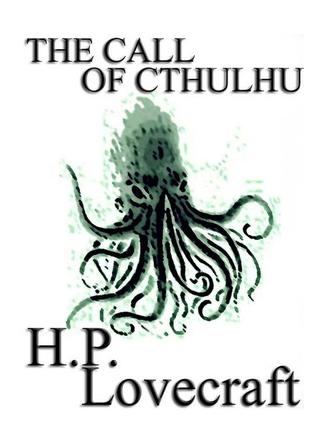Last updated on 2025/08/04
The Call Of Cthulhu Summary
H.P. Lovecraft
Ancient horrors awaken from the depths of madness.
Last updated on 2025/08/04
The Call Of Cthulhu Summary
H.P. Lovecraft
Ancient horrors awaken from the depths of madness.
Description

How many pages in The Call Of Cthulhu?
43 pages
What is the release date for The Call Of Cthulhu?
In the haunting world of H.P. Lovecraft's "The Call of Cthulhu," readers are thrust into a cosmic abyss where humanity's insignificance is underscored by the awakening of ancient, malevolent beings beyond our comprehension. As the protagonist unravels a tapestry of nightmarish dreams, cryptic manuscripts, and horrifying tales that span the globe, he confronts the terrifying realization that something far older and more powerful than mankind stirs beneath the ocean's depths. This gripping tale blurs the lines between sanity and madness, beckoning you to explore the chilling implications of forbidden knowledge and the dread that lies in the unknown depths of existence. Will you heed the call, or will you turn away from the abyss that awaits?
Author H.P. Lovecraft
Howard Phillips Lovecraft, born on August 20, 1890, in Providence, Rhode Island, was an American writer renowned for his unique contributions to the genre of weird fiction and horror. Emerging from a troubled childhood marked by familial instability, Lovecraft developed a fervent interest in strange tales and cosmic horror, leading to the creation of an imaginative universe populated by ancient deities and incomprehensible entities. Although he achieved limited recognition during his lifetime, Lovecraft's posthumous influence has permeated modern horror literature, film, and popular culture, with his seminal works, including "The Call of Cthulhu," continuing to resonate with audiences and inspiring countless authors and artists. His distinctive writing style, characterized by a rich atmospheric prose and a deep fascination with the unknown, solidified Lovecraft's legacy as a pioneer of modern horror, as he explored themes of existential dread and the insignificance of humanity within the cosmos.
The Call Of Cthulhu Summary |Free PDF Download
The Call Of Cthulhu
Chapter 1 | Dagon
In the first chapter of "Dagon," the narrator, burdened by a sense of impending doom, reveals his decision to end his life due to the psychological strain brought on by visions and experiences he cannot escape. Having been captured by a German sea-raider in the early days of World War I, he escapes into the vast ocean, drifting for days before being mysteriously washed ashore onto a grotesque landscape that reeks of decay and lifelessness. As he explores his eerie new surroundings, he comes across a strange expanse of black mud that was once ocean floor, now exposed due to a volcanic upheaval. His initial horror is exacerbated by the oppressive silence and the sight of putrefying fish. He eventually decides to journey towards a distant hummock, which he believes may lead him to safety or help. Upon reaching the hummock, he discovers it to be far more significant than it appeared—it's a towering monolith with carvings and inscriptions that hint at a long-forgotten civilization, suggesting the existence of ancient, aquatic beings. These carvings depict bizarre, humanoid creatures that haunt him with their grotesque forms and barbaric worship rituals. The tale takes a terrifying turn when he witnesses one of these creatures—massive and monstrous—rose from the depths of the water, illustrating the chilling reality of a hidden world beneath the ocean's surface. Overcome by terror, he races back to his boat, eventually ending up delirious and hospitalized after being rescued by another ship. Struggling to find meaning for his experiences, he talks to an ethnologist but finds no validation for his fears. As he grapples with his memories, he contemplates whether his harrowing visions were mere hallucinations borne from fever, yet they persist, leading him to question the darkness lurking in the ocean. With each passing moment, he grows more convinced that these ancient horrors may one day rise again, bringing chaos and destruction to humanity. As he prepares to take his own life, the chapter culminates with a palpable sense of dread and the image of a monstrous hand approaching his door, leaving the reader on edge about what lurks in the shadows. This chapter delves into themes of isolation, existential dread, and the fear of the unknown, setting the stage for cosmic horrors that transcend human understanding.
Chapter 2 | The Statement of Randolph Carter
In Chapter 2 of "The Call of Cthulhu," the narrator, Randolph Carter, presents a haunting account of his last night with his friend Harley Warren, whose fate remains shrouded in mystery. Carter begins by expressing frustration over the repeated questioning about the events that transpired, asserting that he has revealed everything he remembers, albeit under a cloud of confusion and horror. He laments the loss of Warren and recalls their dark explorations into forbidden knowledge, primarily fueled by Warren's obsession with a strange book written in an unknown script. The chapter pivots as Carter describes their ill-fated excursion to a decrepit cemetery, where they ventured with lanterns, spades, and a peculiar apparatus for communication. The atmosphere is thick with dread as they uncover a burial site, revealing a descent into a dark abyss filled with nauseating fumes. Warren, exhibiting an unsettling confidence, insists that Carter remain above ground while he descends into the depths, cautioning that only someone with "ironclad sensibilities" could handle what lay below. As Warren ventures down, Carter's anxiety mounts, exacerbated by the eerie silence surrounding him. When he finally hears Warren's voice through the phone, it is filled with terror, echoing a grievous transformation from calm to alarm. Warren pleads with Carter to flee, urging him to seal the crypt and escape, for something unnatural stirs below. Amid Carter’s desperate insistence to help, Warren’s fear deepens, culminating in an anguished cry before silence descends completely. Carter’s horror escalates as he grapples with the horrifying possibility that Warren might be in mortal danger. As he clings to hope, a chilling voice resounds from the darkness, proclaiming the grim fate of Warren, shattering Carter's psyche. This voice—an unearthly, hollow presence—utterly destabilizes him, leading to a blackout that transports him to an unknown location, where he awakens, haunted by the unspeakable knowledge he has encountered. This chapter immerses readers in themes of forbidden knowledge, the fragility of sanity when confronted with the unknowable, and the profound bond of friendship tested by the depths of terror. Carter's struggle with memory and his desperate choices highlight the tension between curiosity and danger, encapsulating Lovecraft’s signature blend of horror and existential dread.
Chapter 3 | Facts Concerning the Late Arthur Jermyn and His Family
In Chapter 3 of "The Call of Cthulhu," titled "Facts Concerning the Late Arthur Jermyn and His Family," H.P. Lovecraft delves into the disturbing history of the Jermyn family, recounting its legacy of madness and strange ancestry. The chapter opens with a bleak reflection on life and the potential horrors that lurk beneath the surface of human existence, hinting at the unsettling truths that can drive a person to despair, as it did with Arthur Jermyn, who tragically took his own life by self-immolation. Arthur is portrayed as the last of a lineage marked by peculiarities and insanity, rooted in the eccentricities of his forebear, Sir Wade Jermyn, a once-renowned anthropologist whose African explorations were filled with wild tales of lost civilizations and bizarre creatures. The Jermyns, portrayed as a family plagued by mental instability, each descend into their madness in unique ways, with Arthur standing out due to his artistic sensitivity and poetic temperament despite his grotesque appearance. The narrative illuminates the family's tragic history—Sir Wade’s mental decline, marked by obsessive tales of an ancient city and its hybrid inhabitants, leads him to be institutionalized before he dies. Following him, his descendants continue to spiral into degradation and violence, such as Philip Jermyn, who marries poorly and ultimately vanishes during his exploits in Africa. Arthur Jermyn, however, appears to have a spark of greatness, achieving academic success and delving into the work of his ancestors. As he becomes increasingly fascinated by the legends surrounding his family’s African exploits, he embarks on an expedition to the Congo, where he hopes to unravel the mysteries of a lost white ape goddess said to be tied to his ancestry. After a year of research, he learns about the city and its hybrid creatures from an ancient chief named Mwanu, solidifying his determination to find the legendary idol. Upon his return to England, Arthur's excitement builds as he anticipates receiving a box containing the mysterious mummified goddess. However, when the package finally arrives, it leads to a catastrophic turn of events. After dismissing all the servants, Arthur opens the box and emits a horrifying scream—witnessed by the butler—and rushes out of the house, drenched in oil, before setting himself ablaze on the moor. The chapter culminates in the chilling revelation that the goddess he sought was, in fact, a mummified white ape, with characteristics shockingly reminiscent of Arthur himself, thus culminating in a grotesque family legacy that drives him to his end. Themes of identity, the grotesque nature of heritage, and the thin line between fascination and horror underscore this chilling tale. The Jermyn family's downfall serves as a stark reminder of the destructive potential of ancestral madness and the haunting pursuit of forbidden knowledge. In the aftermath, Arthur’s story and existence are almost erased, buried with his remains and the horrid discovery that accompanied his fate, serving as a grim commentary on the obsession with unearthing the past—something which, in this case, leads only to tragedy.
Chapter 4 | Celephaïs
In "Celephaïs," we meet Kuranes, a man who escapes the dreariness of his life in London through vivid dreams of a magnificent city called Celephaïs nestled in the Valley of Ooth-Nargai. Once a prominent part of a long line of his ancestors, Kuranes finds himself isolated and impoverished, and he turns to dreaming as a refuge, crafting an alternate reality filled with beauty and wonder that starkly contrasts with the harshness of his waking life. As he withdraws further from the real world, his dreams become more enchanting, allowing him to explore the fantastical landscapes of his childhood imagination. In his dreams, Kuranes revisits the familiarity of his origin, including the ancient stone house where he grew up. He first glimpses the idyllic city of Celephaïs when he dreams of plunging into an abyss and floating down to the radiant city, setting the stage for his desire to experience it fully rather than merely in dreams. When he returns to Celephaïs fully awake, he finds everything as he remembered, from the lush greenery to the welcoming townsfolk who greet him as if he had never left. Kuranes's longing for adventure leads him to sail on a galley across the Cerenerian Sea towards the ethereal city of Serannian, a journey that seems suspended in time and reality. However, as he reaches the brink of this dream world, he is abruptly awakened back in London, leaving him frustrated and yearning for Celephaïs once more. His desperate search for this mythical city grows futile in the waking world, leading him to experiment with drugs, trying to recapture the bliss of his dreams. Ultimately, fulfillment arrives unexpectedly when Kuranes is met by a cortege of knights from Celephaïs. They honor him as the creator of the city in his dreams and invite him to assume his place as its chief god. As they ride through the countryside, Kuranes experiences a time-traveling sensation, witnessing the landscape transform into the vibrant scenes of his past. Upon reaching the abyss, he joins the knights in a spectacular descent into the realm of dreams, finally claiming his place in the beloved city of Celephaïs. In his new life, Kuranes reigns with joy over Ooth-Nargai, fulfilling his idealistic aspirations and escaping the grim reality of London, paradoxically juxtaposing his vibrant dream existence with the fate of a wandering tramp found dead on the shores nearby. The chapter encapsulates themes of escapism, the conflict between reality and imagination, and the timeless allure of dreams providing a sanctuary from life's harshness. Kuranes's journey reflects the deep human desire for beauty, adventure, and purpose, celebrating the richness of imagination and dreams.
Chapter 5 | Nyarlathotep
In this chilling chapter, the narrator introduces us to the eerie influence of Nyarlathotep, a mysterious figure emerging from ancient Egypt. The atmosphere has been thick with dread; a sense of societal turmoil and an ominous, inexplicable danger grips the populace. People walk around with haunted expressions, filled with whispers of nameless fears that seem to lurk in the shadows. There's a palpable feeling that something sinister is taking hold of the world, where even the seasons seem out of balance. Nyarlathotep is described as a tall, dark figure resembling an ancient Pharaoh, who appears as a harbinger of unsettling prophecies. He captivates crowds with his strange displays of power and odd instruments that evoke both awe and terror. His presence disrupts the peace, causing nightmares that plague the city at night. The narrator, drawn by his friend's stories of Nyarlathotep's unsettling yet alluring revelations, decides to attend one of his exhibitions. As he arrives in the crowded, suffocating space filled with anxious spectators, he witnesses disturbing images projected onto a screen—ghastly figures amid ruins and the world contending against dark forces from beyond, reminiscent of an impending doom. Despite his skepticism, the performance overwhelms him, and he joins others in a fearful exodus into the night, attempting to convince one another that all remains unchanged. But as the electric lights fade, an inexplicable force guides them into the depths of the night. The experience becomes surreal and disorienting. The streets morph into strange landscapes, with the very fabric of reality unraveling around them. The narrator's companions, seemingly under a spell, wander off in different, ominous directions—some laugh maniacally, others vanish into the shadows. The narrator, feeling a deep chill, hesitates but is ultimately pulled toward an inscrutable abyss, where he encounters blinding snow and a dreadful sense of something sinister lurking beyond. His journey leads him into a realm of nightmarish visions, where he is confronted by the haunting remnants of lost worlds and the foreboding presence of monstrous entities that embody Nyarlathotep's dark essence. The chapter culminates in a nightmarish realization that connects the horrific and the unfathomable—an exploration of the existential dread that Nyarlathotep brings to human consciousness, hinting at the vulnerability of humanity against forces beyond comprehension. Through vivid imagery and the mounting sense of horror, the chapter encapsulates themes of fear, the unknown, and the fragile nature of reality, all personified in the figure of Nyarlathotep, the embodiment of chaos and darkness.
Chapter 6 | The Picture in the House
In "The Picture in the House," an eerie narrative unfolds in the remote backwoods of New England, drawing readers into a haunting world steeped in isolation and grotesqueness. The tale begins with a reflection on the allure of horror that beckons adventurers to strange, abandoned places. The protagonist, an unnamed narrator, is on a genealogical quest in the Miskatonic Valley when a torrential rainstorm drives him to seek shelter in a decrepit old farmhouse that emanates an unsettling aura. As he approaches the house, he feels a mix of trepidation and curiosity, exacerbated by the house’s unsettling silence and the feeling that it has secrets to unveil. Though initially perceiving the house as abandoned, the narrator’s instincts shift as he realizes it might still be inhabited. After a moment's hesitation, he opens the unlatched door and steps inside, immediately assaulted by a strange odor and a sense of foreboding. Inside, he discovers a low-ceilinged sitting room that appears frozen in time, overflowing with antiquated furnishings and relics. Among these is an astonishingly rare book: Pigafetta’s account of the Congo printed in 1598. Captivated, the narrator momentarily forgets his unease but is soon disturbed by the gruesome illustrations within. His apprehension spikes further upon hearing heavy footsteps above, defying the eerie silence that preceded his entry. The footsteps belong to a peculiar old man—unkempt, yet imposing. His demeanor oscillates between unsettlingly pleasant and disturbingly strange. Despite the man’s disheveled appearance, he engages the narrator in conversation, revealing his love for the very book that had intrigued the narrator. This interaction slowly reveals the old man’s eccentricity and unsettling depths, particularly with his disturbing fascination with the cannibalistic illustrations, which he expresses with a childlike glee that horrifies the narrator. As the old man's fixation grows, his ramblings become increasingly worrisome, expressing a curious, almost sinister relationship with the brutal imagery of the book. He hints at a dark craving sparked by the illustrations, culminating in a moment that magnifies the horror of the encounter as a drop of blood appears ominously on the page. Just as the narrator is engulfed in revulsion and dread, a thunderous storm strikes, shaking the already frail structure and driving him into a blackout. Themes of madness, obsession, and the grotesque permeate the story. The old man's almost childlike delight in horror and violence starkly contrasts with the narrator’s growing fear and repulsion, creating a haunting exploration of how isolation and ignorance can breed darkness. In this chilling tale, Lovecraft immerses readers in a reality where the line between fascination and horror is perilously thin, leaving a lingering sense of dread long after the story ends.
Chapter 7 | The Outsider
In "The Outsider," the narrator recounts a haunting journey of self-discovery, steeped in themes of isolation, fear, and the longing for belonging. The story begins with a poignant reflection on a childhood filled with fear and darkness, set in a decrepit castle where the narrator grew up in utter solitude, surrounded by the eerie remnants of past generations. There were no signs of life, save for the silent creatures that inhabited the shadows, leaving him disconnected from any sense of human warmth or companionship. Books became his only portals to knowledge and imagination, shaping his understanding of the world beyond the oppressive walls that contained him. As the tale unfolds, the narrator's desire for light and freedom crescendos into a daring decision to climb the castle's black, ruined tower, a metaphoric embodiment of his yearning to escape the confines of his dark existence. After a perilous ascent through a dank and deserted vertical shaft, he ultimately reaches what he believes is the pinnacle of his endeavor; however, he is met not with the sky he craves, but with the shocking revelation of a marble chamber. Oblivious to the true nature of his surroundings, he stumbles into the moonlit world, depicting an idyllic scene of revelry at an ancient castle nearby. However, upon entering a vibrant gathering, he is met with a horrific reaction from the partygoers, who recoil in terror at his presence. This inexplicable terror blindsides him and sets off chaos, revealing the disconnect between his existence and the world he desperately wanted to be part of. In a moment of tragic confrontation, he comes face to face with a grotesque creature that embodies decay and death—an unnerving realization that he himself is the outsider. As recollections of his true identity flood back, he understands that he is not a participant in life’s vibrancy but rather an abomination, forever estranged from humanity. The experience is so traumatic that it drives him to flee, retreating into the moonlight where he finds solace among the ghouls, choosing the company of the night rather than the light of day. Ultimately, the narrative captures the essence of alienation and existential dread, illustrating how the quest for belonging can lead to terrifying revelations. Despite gaining freedom from his confined castle, he resigns to his identity as an outsider—one who finds comfort in the shadows rather than in the warmth of humanity. The story's conclusion leaves the reader with a haunting sense of loss, the bittersweet contrast between the quest for connection and the harsh truth of an unbridgeable divide.
Key Point: The Quest for Belonging Can Unveil Hidden Fears
Critical Interpretation: As you journey through life, the haunting exploration of the narrator’s quest for belonging in 'The Outsider' resonates deeply. It serves as a mirror reflecting our own desires for connection and acceptance, yet it also challenges you to confront the shadows within. Just as the narrator faces the terrifying truth of his alienation, you too may find that the pursuit of belonging can unearth fears of inadequacy and isolation. This realization can inspire you to embrace your true self, fostering an understanding that even amidst a world filled with vibrant connections, acknowledging your uniqueness can lead to deeper self-acceptance. The journey of accepting oneself, despite the darker edges, illuminates the path toward genuine relationships, inviting you to step into the light with courage and authenticity.
Chapter 8 | Herbert West—Reanimator
In "Herbert West—Reanimator," the tale unfolds through the eyes of a nameless narrator who recalls his unsettling friendship with Herbert West, a brilliant yet deeply disturbed medical student. Their story begins at Miskatonic University Medical School, where West is ridiculed for his audacious theories about overcoming death through reanimation. Despite the skepticism of professors and peers, West's meticulous experiments on animals yield alarming results, notably glimpses of life in corpses he attempts to revive. Through his obsession with the mechanics of life and death, West becomes increasingly dissatisfied with his limitations and resolves to continue his experiments in secret. The duo begins their grim work by exhuming fresh bodies from local graves, operating under the cover of darkness in a secluded farmhouse. Their first attempt ends horrifically, leading to a cacophony of anguished cries that haunts both men and leads to whispered rumors around town. Over time, West's experiments become desperate and reckless, culminating in a series of grotesque failures that leave the narrator understandably shaken. As years pass, the plague ravages Arkham, providing West a morbid supply of fresh specimens, but even amidst the chaos, his unethical methods only deepen the chasm of terror surrounding him. His attempts to animate a human body lead to another shocking discovery: reanimated beings can retain glimpses of their past, as one specimen screams in terror before collapsing in finality, revealing the cost of their experiments. World War I takes West to the battlefield, where he views the chaos and death as an opportunity for further experimentation, desensitized to the human cost of his work. His experiments grow more horrid; the treatment of a decapitated major leads to the monstrous realization of what they have unleashed. In a pivotal moment of horror, West successfully animates a headless body, leading to nerve-rending occurrences that blur the lines between life and death. West's fate unravels as he becomes increasingly paranoid, fearing not only the consequences of his actions but also the monstrous beings he has created. In a climactic return to his former laboratory, the reader learns of a disastrous experiment involving old masonry that awakens boundless horror, revealing a multitude of grotesque creatures. The finality arrives when West is overwhelmed and fatally torn apart by these abominations, leading to the narrator's collapse into madness. Themes of obsession, the ethical implications of scientific exploration, and the interplay between life and lifelessness loom large in the narrative. Ultimately, "Herbert West—Reanimator" constructs a chilling tale of ambition turned monstrous, leaving readers pondering the grim possibilities of meddling with the natural order.
Chapter 9 | The Hound
In "The Hound," the narrator is haunted by a grotesque past shared with his friend, St. John, culminating in a chilling series of events that lead to madness and despair. After becoming jaded with life and its banalities, both friends plunge into the macabre world of grave-robbing, driven by a disturbing desire for novelty and thrill. Their secretive excursions reveal a hidden underground museum filled with grotesque artifacts, each more grotesque than the last, feeding their dark sensibilities. However, their quest for excitement spirals into a nightmare when they unearth an ancient grave in a Dutch churchyard, finding a jade amulet that resonates with malevolence. As they take possession of this artifact, strange occurrences begin to plague their isolated home in England. They experience unsettling noises and glimpses of ominous shadows, while the eerie sound of a distant baying seems to follow them wherever they go. St. John, increasingly affected by their descent into horror, ultimately falls victim to a terrible beast that seems to embody the malevolence linked to the amulet. In his dying moments, he cryptically refers to the amulet, emphasizing its cursed nature. The narrator, now alone and gripped by dread, decides to rid himself of the amulet, but not before experiencing further terror. His attempts to return it to the grave only lead him deeper into madness when he learns he has been robbed of this final hope for redemption. Upon returning to the churchyard, he uncovers the coffin once again, only to find the skeletal remains more horrifying than he remembered, now alive with malevolence and flanked by grotesque bats. The realization that the very amulet he took is clutched in the claws of the dead creature unravels him completely, leading to a frenzied escape filled with laughter tinged with insanity. At its core, "The Hound" explores themes of obsession, the insatiable thirst for experiences beyond the commonplace, and the monstrous consequences of disturbing the dead. It leaves the reader with a chilling notion of the unseen horrors lurking beneath the surface of reality, illustrating a descent into madness fueled by curiosity and the macabre. The conclusion highlights the futility of seeking escape from one's sins, as the baying of the inevitable doom draws ever closer.
Chapter 10 | The Rats in the Walls
In "The Rats in the Walls," the tale unfolds through the lens of an unnamed narrator who moves into the restoration of Exham Priory, a dilapidated estate linked to his ancestral line. This priory, he learns, has been uninhabited since the tragic night centuries ago when his ancestor, Walter de la Poer, was accused of murdering his family under mysterious and ominous circumstances. As the narrator delves into the history of his lineage, he learns of dark legends, familial curses, and bizarre, sinister rituals associated with his heritage. Upon moving in on July 16, 1923, a sense of unease comes over him as the villagers of Anchester exhibit a deep-seated fear and hatred of the priory, viewing it as a haunt of malevolence. Despite the efforts of the narrator to distance himself from the horrors of his family's past, unsettling occurrences arise. His cats, particularly his favorite, Nigger-Man, begin to behave erratically, sensing something amiss in the dormant walls of the ancient structure. Strange sounds echo through the night, resembling scurrying rats, although he dismisses these occurrences at first as mere figments of an overactive imagination. As time progresses, manifestations of vermin become more pronounced. The narrator's curiosity leads him to explore the sub-cellar of the priory, where shocking secrets of his ancestry and the grotesque history of the priory begin to surface. One night, with his friend Captain Norrys by his side, they uncover remnants of a gruesome past—human bones gnawed by rats and architectural fragments revealing hints of unspeakable rituals tied to the worship of ancient deities. The horror escalates as they discover the existence of a subterranean grotto, filled with skeletal remains in various states of decay. These unsettling findings suggest that the de la Poers might have participated in horrific pagan rites, and the descendants of the creatures involved were kept in captivity—pitting notions of family legacy against the darkest forms of humanity. The climax of unspeakable terror reveals itself when the narrator, consumed by fear and the relentless echo of his ancestral lineage, succumbs to madness, committing an unthinkable act amid an overwhelming frenzy of rats. Ultimately, he is confined to an asylum, haunted by the incessant scurrying of rats, left terrified and wondering whether he is truly a de la Poer—a legacy he now views as profoundly cursed. Themes of ancestral guilt, the inescapability of history, and the thin veneer between civilization and primal horror echo throughout the story, creating a vivid tapestry of dread that lingers long after the final page. In "The Rats in the Walls," Lovecraft weaves an intricate narrative that dives deep into the unexplored fears surrounding heritage, the madness associated with legacy, and the lurking horrors of what once thrived beneath the surface of human civilization.
Chapter 11 | The Festival
In "The Festival," the protagonist, drawn by an ancestral call, journeys to the ancient seaside town of Kingsport during Yuletide, a time that the locals celebrate with esoteric rituals dating back to an even older tradition. As he approaches the town, he marvels at its picturesque yet eerie atmosphere, characterized by crooked streets, colonial houses, and graveyards dusted with snow. The protagonist, reflecting on his lineage, remembers that his forefathers, once forbidden from celebrating, were mandated to observe a festival every century to maintain the legacy of their mysterious heritage. Upon arriving at his ancestral home, he encounters an old man who, despite signaling his inability to speak, welcomes him into a dimly-lit room filled with antiquated furniture and unsettling artifacts. Among the old books he peruses is the infamous "Necronomicon," which fills him with dread. The atmosphere becomes increasingly unsettling, amplified by the old man and woman who appear to be more than they seem. Soon, the time for the festival arrives, and the protagonist, led by the old man and the old woman, joins a host of hooded figures moving silently through the cold night. They ascend towards an ominous church at the town’s peak, where a gathering for a sinister rite is taking place. The churchyard bears witness to deathly flames and a gathering of attendees who descend into a dank crypt. There, the ritual unfolds around a bizarre, sickly-green flame and an oily river, revealing grotesque creatures and horrors that terrify yet beckon the protagonist into a vortex of ancient malevolence. As the ritual intensifies, the protagonist succumbs to the madness that permeates the scene, witnessing a horde of otherworldly beings and the dark celebrations that honor primordial forces. An encounter with the old man reveals a horrifying truth about his lineage, pushing him to the brink of sanity. In a moment of panic, he leaps into the abyss of the oily river to escape the horror he can hardly comprehend. Rescued later, he awakens in a hospital, told he fell and lost consciousness. All around him appears normal, yet the dread of his experience lingers. The protagonist grapples with terrifying memories, filled with echoes of the unmentionable rituals he witnessed. Amidst the reassurances that nothing sinister happened, he remains haunted, filled with anxiety about the dark lineage he has seemingly inherited, and the contents of the "Necronomicon" bounce hauntingly in his mind, preying on his sanity with the knowledge of the unspeakable horrors lurking beneath the surface of reality.
Chapter 12 | He
In Chapter 12 of "The Call of Cthulhu," the narrator reflects on his disillusionment after moving to New York, where he sought inspiration but instead found horror and an overwhelming sense of loneliness. Initially enchanted by the city’s beauty at sunset, his awe quickly dissipated under the harsh daylight, revealing a squalid and alien environment that seemed devoid of life and dreams. Struggling with feelings of isolation, he began to explore hidden corners of the city at night, where he found some solace among the remnants of a past he romanticized. One fateful night, in a secluded courtyard in Greenwich, he encounters a mysterious, cloaked man. This figure, who appears both noble and unsettling, offers to guide the narrator through the forgotten areas of the city, promising insights into its history. Intrigued by the prospect of discovering lost beauty, the narrator follows him through twisted alleyways and abandoned corridors, leaving behind the modern world. The man leads him to a decrepit library filled with artifacts from a bygone era. Revealing himself as a descendent of an eccentric squire who had delved into strange arts, he speaks of their family’s secrets involving the supernatural and Native American rituals that once thrived on the very land. His voice is soft yet commanding, stirring a mix of fascination and dread in the narrator. As they gaze out a window, the hooded man demonstrates his ability to conjure visions of the past. Initially, he shows idyllic scenes from the narrator's own time, but as the glimpses grow darker and more chaotic, the atmosphere shifts dramatically. In a terrifying reveal, the narrator witnesses a grotesque event in a hellish city, swarming with grotesque figures and unspeakable noises, sending him into a panic. His screams echo through the room, disrupting a terrifying ritual that he can hardly grasp. Suddenly, the atmosphere changes. The old man grows frantic, sensing something dreadful approaching. The narrator watches in horror as the man transforms and diminishes in front of him, overtaken by unseen forces that seem to want revenge. The climax builds with pounding on the door and a sense of impending doom, leading to the horrifying entrance of a dark mass that swallows the man whole. In the chaos, the narrator escapes just as the building collapses around him, crawling free but severely injured. He emerges back into the world outside, forever altered by what he experienced. The chapter concludes with his determination to leave behind the horrors of the city, seeking refuge in the familiar, untouched New England he longs for. This chapter weaves themes of disillusionment, the haunting power of history, and the thin veil between reality and the supernatural, crafting a rich tapestry of terror and existential contemplation in Lovecraft's iconic style.
Chapter 13 | Cool Air
In "Cool Air," the narrator reveals his aversion to cool air through a chilling story that explains his fear. He recounts his experiences living in a seedy boarding house in New York City in 1923. Seeking affordable accommodation, he discovers a decaying brownstone run by a gruff landlady named Mrs. Herrero. Among the tenants is Dr. Muñoz, a mysterious and increasingly reclusive physician suffering from undefined ailments. The narrator first learns of Dr. Muñoz through a peculiar incident involving ammonia dripping from the ceiling, leading him to engage with the doctor out of desperation after experiencing a heart attack. When he visits Dr. Muñoz's apartment, he is initially struck by the surprising elegance of the doctor's living quarters, in stark contrast to the shabby boarding house. The doctor impresses him with his knowledge and dedication to combating death, although the narrator cannot shake off an unsettling feeling towards him, fueled by the man's cold presence and bizarre habits. Over time, the doctor’s health deteriorates, and he becomes increasingly obsessed with cold air and the nature of death, even employing dubious methods in his experiments. As fall approaches, Dr. Muñoz's physical state declines sharply. The narrator assists him in modifying his refrigeration system to maintain a frigid environment necessary for the doctor’s well-being. However, when the cooling system breaks down one fateful night, Dr. Muñoz's panic escalates into terror. Despite frantic efforts to restore the cold, the situation spirals out of control, leaving the narrator grappling with dread as he senses something horrific is unfolding. Eventually, the narrator discovers the outcome of this chilling scenario when he breaks into Dr. Muñoz’s room, only to find a grotesque scene that is both horrifying and inexplicable. He uncovers a final message scrawled in a frenzied hand, revealing that Dr. Muñoz had been using unnatural methods to prolong his life after having essentially died eighteen years prior. The narrative ends with the narrator admitting his lasting fear of cool air, a traumatic reminder of the dreadful events he has witnessed and the profound horror of what Dr. Muñoz attempted to achieve through unnatural means.
Chapter 14 | The Call of Cthulhu
In Chapter 14 of H.P. Lovecraft's "The Call of Cthulhu," the narrative weaves a tale steeped in cosmic horror and the unknown, focusing on the suppressed knowledge of a terrifying cult and the monstrous entity known as Cthulhu. The narrator, Francis Wayland Thurston, begins by reflecting on the fragility of human understanding when confronted with the vastness of the universe and humanity's dark past, hinting that hidden truths can lead to madness. Thurston recounts the mysterious death of his grand-uncle, Professor George Gammell Angell, an expert in Semitic languages, whose passing leaves behind puzzling notes and a disquieting bas-relief. This artifact is adorned with hieroglyphics and depicts a grotesque creature, raising questions about its significance. The professor was involved in piecing together reports from various individuals who experienced strange dreams involving Cthulhu, a name first associated with the bizarre bas-relief made by artist Henry Anthony Wilcox, who had bizarre dreams influenced by a recent earthquake. Wilcox's dreams reveal monstrous, Cyclopean cities and a primal chant, "Cthulhu fhtagn," indicating a deep-seated relation to an ancient cult. As the narrative unfolds, Thurston discovers that several others, especially artists and poets, reported similarly haunting dreams during the same time, hinting at a collective psychosis or a shared subconscious connection to the old cult. Further intrigue arises with the account of Inspector John Raymond Legrasse, who, in 1908, had confronted a horrifying voodoo cult in the swamps of Louisiana. During a raid, Legrasse discovers a hideous stone idol that closely resembles Wilcox's creation. The cultists venerate ancient entities, now lying dormant beneath the sea, foreshadowing a potential resurgence when "the stars are right." Thurston connects these events to other global occurrences of madness and panic. He uncovers newspaper articles detailing strange happenings across the world, from a London suicide to riots in Africa, all aligned with the themes of dread and ancient rites tied to Cthulhu's cult. This suggests a wider, pervasive influence of Cthulhu's legacy on the human psyche. As Thurston delves deeper into the mystery, he encounters a survivor named Gustaf Johansen, who recounts a harrowing encounter at sea with another crew who worship Cthulhu. Johansen’s chilling experiences and the horrors he describes blur the lines between reality and nightmare, leading Thurston to grapple with the implications of the cult’s existence and the true nature of the entity they venerate. The chapter crescendos with themes of forbidden knowledge and existential dread. Thurston fears that knowing too much about the cult and Cthulhu's reality may lead to his own undoing, as he contemplates the cyclical nature of madness and horror that binds humanity to these ancient secrets. The tale concludes with a lingering sense of unease, asserting that Cthulhu and the cult may rise again, leaving readers with an ominous reminder of the thin veil separating sanity from the abyss of cosmic terror.
Key Point: The fragility of human understanding in the face of the unknown
Critical Interpretation: Imagine standing on the precipice of the vast universe, where every whispered secret of the cosmos hints at unimaginable truths just beyond your grasp. This chapter serves as a haunting reminder that our knowledge is but a fragile construct, easily shattered by the revelation of dark truths lurking in the shadows. Embrace the humility that comes with recognizing our limitations, and allow it to inspire you to seek deeper understanding in your own life. It teaches you that while certainty is comforting, the true beauty lies in the exploration of the unknown, urging you to expand your horizons, confront your fears, and grow from the mysteries that both terrify and fascinate you.
Chapter 15 | The Colour Out of Space
In "The Colour Out of Space," the story unfolds in the eerie, isolated region west of Arkham, where ancient forests and abandoned farms harbor unsettling secrets. The narrative begins with a vivid description of desolate landscapes, notably a peculiar area cursed as the "blasted heath." Locals, including an elderly man named Ammi Pierce, speak in hushed tones about the area's dark past, which is linked to an unsettling meteorite that fell several decades ago. The tale centers on Nahum Gardner, whose family experiences a string of bizarre events after the meteorite crash. At first, the meteorite attracts scientific attention due to its strange properties, exhibiting unusual heat and magnetism, and displaying an unknown spectrum. However, when Nahum attempts to capitalize on the meteor’s fame, he finds that the once-fertile ground around his farm begins to decay. Crops that initially thrive soon become unpalatable, and an unease settles over his household. As the story progresses, the Gardner family begins to suffer physical and mental deterioration. Nahum's wife goes mad, his sons display erratic behavior, and eventually, they begin to disappear or die under mysterious circumstances—seemingly consumed by an insidious force tied to the water from their well. This mysterious ‘colour,’ which Ammi associates with the meteorite’s strange properties, gradually invades the lives of those living nearby, leading to horrific transformations, both physically and psychologically. The climax arrives when the house descends into chaos, with the remaining family members facing their doom. As Ammi Pierce visits out of concern, he discovers the appalling fate that has befallen the Gardners and confronts a palpable, dreadful presence. The ultimate revelation is that this presence seems to emanate from the well, further fueling Ammi's horror as it resembles the gluttonous nature of the strange meteorite’s remnants, which is now creeping and consuming all life around. In the end, after a horrendous explosion of otherworldly occurrences, Ammi and other townsfolk witness the Gardner farm engulfed in a strange glow, culminating with a nightmarish entity shooting into the sky, leaving the land desolate and lifeless. The story closes on a chilling note, hinting at the lingering evil that persists in the area, while Ammi becomes bound to the memory of those horrific events, forever haunted by the presence of the “colour” that has tainted their existence. Themes of isolation, the unknown, and the collision of nature with cosmic horror permeate the narrative. Lovecraft blends the everyday with the extraordinary, using the Gardner family's gradual decline as a poignant commentary on the fragility of human life against unknown forces. The “colour” serves as a symbol of alien terror, embodying the fear of the incomprehensible, as well as the consequences of humanity's curiosity toward the unknown.
Chapter 16 | The Whisperer in Darkness
"The Whisperer in Darkness" is a chilling tale by H.P. Lovecraft that blends folklore with cosmic horror, exploring themes of fear, alienation, and the unknown. It begins with the narrator, Albert N. Wilmarth, reflecting on a profoundly unsettling experience that led him to flee Henry Akeley's Vermont farmhouse in terror. Akeley, a reclusive scholar, had corresponded with Wilmarth about bizarre occurrences following the Vermont floods of 1927, including sightings of strange shapes in the waterways, which sparked a debate about local folklore. The story dives into eerie folklore, recounting ancient legends of strange beings, described as monstrous and crab-like, believed to inhabit the secluded hills. Despite his skepticism, Wilmarth's curiosity is piqued by Akeley's insistence that these beings are real. As Akeley shares terrifying information about hidden creatures and the cosmic knowledge they possess, Wilmarth’s initial doubt wavers, leading him into the heart of a dangerous investigation. Akeley claims that these beings are not only real but may have been observing humanity, and he proposes to connect with them more intimately. As their correspondence unfolds, Akeley sends Wilmarth a letter detailing his growing fear of these creatures. He explains that they come from another planet, and that he has discovered evidence of their presence. Akeley ultimately expresses a sense of impending doom, fearing that his discoveries could lead to dire consequences. The tension escalates with Akeley's deteriorating mental state, culminating in the arrival of Wilmarth at Akeley's farmhouse. A guide named Noyes meets him at the train station, claiming Akeley is too ill to greet him. Once at the house, Wilmarth finds Akeley’s absence jarring and recalls the unsettling sounds he heard while falling asleep, eventually realizing he was never truly alone. As rumors of strange happenings continue, including Akeley’s increasingly paranoid behavior, Wilmarth begins to feel the oppressive presence of the beings whispered about in folklore. After a night filled with strange voices that include buzzing alien sounds, he discovers Akeley’s empty chair, draped with his clothes, suggesting he has vanished. In a desperate escape, Wilmarth races through the darkened hills, consumed by horror and uncertainty, realizing he has stumbled upon a reality far beyond human comprehension. When authorities later investigate, they find only the remnants of Akeley’s clothing and no trace of him or the bizarre occurrences he spoke of, casting doubt on the validity of Wilmarth’s experience. The narrative explores the tenuous nature of reality and the danger of uncovering truths that humanity is not meant to know. The shift from skepticism to dread, along with the chilling cliffhanger that implies a sinister reality lurking just beyond human perception, encapsulates Lovecraft’s unique approach to cosmic horror. The conclusion leaves readers questioning the boundaries of sanity, existence, and the realms that lie beyond human understanding, exemplifying a profound fear of the unknown.
Key Point: The danger of uncovering truths beyond human comprehension
Critical Interpretation: In 'The Whisperer in Darkness,' you are reminded of the fine line between knowledge and peril. As you delve into the mysteries of existence, it inspires you to embrace curiosity and learn, yet it cautions you to respect the boundaries of what should remain unknown. This awareness can guide you in your pursuits, urging you to seek understanding without losing yourself in the abyss of dark knowledge, reminding you that not all truths are meant to be discovered. Your quest for knowledge should be coupled with humility before the vast, unfathomable universe.
Chapter 17 | The Shadow Over Innsmouth
In "The Shadow Over Innsmouth," the narrator recounts a chilling encounter with the deteriorating and mysterious town of Innsmouth, Massachusetts. During the winter of 1927-28, the U.S. government conducted secret raids in Innsmouth, leading to arrests and the destruction of numerous decrepit houses. The locals remained tight-lipped, heightening the town's enigmatic aura. The narrator, intrigued by whispers of Innsmouth's dark legacy while compiling genealogical research, decides to visit. Upon arrival, the town is a shadow of its former self, plagued by decay and inhabited by strange, unsettling residents who bear an odd, "Innsmouth look." He boards a decrepit bus driven by Joe Sargent, where his discomfort deepens as he experiences a growing aversion to the strange sight of the townsfolk and the eerie atmosphere that surrounds him. Once in Innsmouth, he finds the town largely deserted, with only a handful of sullen adults and children seen. The narrator discovers references to a peculiar cult known as "The Esoteric Order of Dagon," which replaced traditional worship in the town. His exploration of Innsmouth’s abandoned streets leads him to unsettling encounters that stir his suspicions and fears. He learns about the Marsh family, connected to rumored devil-worship and strange sacrifices, especially around the malevolent Devil Reef. Guided by a drunken old man named Zadok Allen, who reveals cryptic hints about civilization beneath the sea and the dark dealings of Captain Obed Marsh with monstrous sea deities, the narrator's anxiety escalates. Zadok speaks of a bargain made with a species of half-fish, half-human beings that inhabit the depths of the ocean, exchanging human sacrifices for an abundance of fish and treasures. This revelation plunges the narrator into a nightmare when he believes he sees the grotesque forms of the Deep Ones emerging from the sea, leading him to escape the town in terror. He eventually reaches a nearby railway, recounting his experience with a surreal blend of fascination and horror. However, the reality of Innsmouth proves even more insidious, and as a consequence of his ancestry, he realizes he may be tied to Innsmouth's dark legacy. Haunted by dreams of aquatic splendor and an unsettling identity crisis, the narrator struggles with the implications of his lineage, yearning for the mysteries of the deep while battling an encroaching madness. The story concludes with ominous suggestions that he may ultimately succumb to the siren call of the abyss, a chilling testament to the grasp that Innsmouth has over its residents and those who cross its threshold. Lovecraft intertwines themes of isolation, forbidden knowledge, and the primal fears of degeneration into the fabric of this haunting tale, leaving readers with a lingering sense of dread.
Key Point: The dangers of forbidden knowledge and the consequences of ignoring one's heritage.
Critical Interpretation: As you navigate through life, realize that curiosity can be a double-edged sword. The lesson from Innsmouth whispers a profound truth: knowing too much about our past or seeking secrets not meant for us can lead to unimaginable consequences. Embrace your roots and be mindful of the knowledge you pursue; it may reveal a side of existence that challenges the very fabric of what you believe. Seek balance, for while understanding can illuminate your path, it can also unveil shadows that, once encountered, are difficult to escape.
Chapter 18 | The Haunter of the Dark
In "The Haunter of the Dark," the story revolves around Robert Blake, a writer and artist who becomes captivated by an abandoned church on Federal Hill, which is shrouded in superstitions and dark history. The narrative begins with speculation about the mysterious circumstances surrounding Blake’s death, initially attributed to lightning or a shock, yet hinting at more sinister possibilities connected to the church. Blake moves to Providence, settling into an old, quaint house where he spends his time writing and painting stories steeped in horror and mythology. His fascination with the deserted church deepens, spurred by its looming presence in the cityscape and local legends about its dark past. He learns that the church had housed a controversial sect known as the Starry Wisdom, associated with odd rituals and mysterious disappearances. Driven by an obsessive curiosity, Blake finally ventures to the church, where he discovers its dilapidated state, still marked by an aura of evil that seems to repel even the birds. After an encounter with a fearful policeman who discourages him from pursuing the building, Blake overlooks this sage advice and enters through a crumbling window. Inside, he discovers a trove of forbidden books and a chilling skeleton of a previous explorer who vanished while seeking the same terrifying truths. Notable among Blake's findings is a peculiar stone, the "Shining Trapezohedron," which the texts suggest can reveal terrifying cosmic knowledge when gazed upon. Entranced, Blake becomes increasingly obsessed with the stone and its implications, verbalizing fears of what he unleashes by touching it. As summer progresses, Blake's entries in his diary reflect a spiraling descent into madness, marked by disturbed dreams and the awareness of an unseen force that watches him. Local fears escalate after Blake's exploration of the church coincides with strange disturbances reported by the local Italian community, who suspect that the “thing” in the steeple is stirring to life. On a fateful night during a storm, the lights go out across the city, unleashing terror as the cherished protection of light fails. Blake writes frantically in his diary, merging reality with visions of cosmic horrors and the nature of existence itself. As the storm rages, he feels the influence of the dark entity from the stone pressing against his psyche, making him question his reality and identity. The climax arrives with an explosion of supernatural phenomena, coinciding with a moment of twisted fate — causing Blake to perish in an allegedly accidental yet horrific manner, leaving behind a last entry filled with dread and cosmic significance. His death provokes speculation among scholars and the community about the true nature of the entity he encountered. The story closes on an enigmatic note, with the curious stone and its sinister past cast into the depths of the ocean, leaving a lingering sense of unease about the forces Blake attempted to understand and the horrors that may still lurk beneath the surface. Overall, the chapter explores themes of curiosity leading to madness, the seductive nature of forbidden knowledge, and the chilling reality of cosmic horror packed into a richly atmospheric setting, leaving readers with an ambiguous yet haunting finale.










